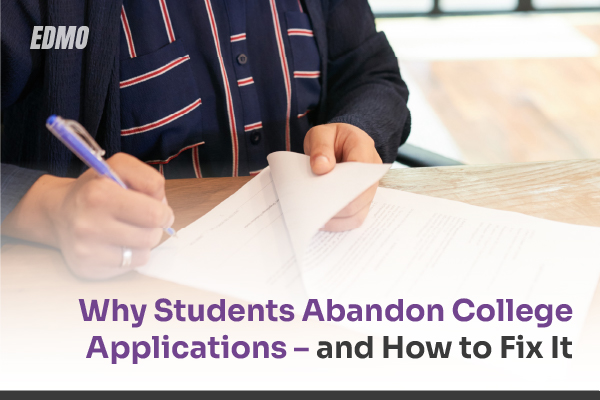At EDMO, we believe in a simple idea: what gets measured gets managed. By focusing on the right data, schools can make a real difference in outcomes for their students. How do we do this? Increasing student retention and student persistence.
This approach is especially effective in student retention, where even small changes in rates can significantly impact a school’s financial health. Since universities depend on students completing their degrees, the metrics used to measure retention and persistence reveal a lot about a school’s approach to supporting students.
Let’s clarify the distinction between student retention and student persistence—two related but distinct concepts—and explore how institutions can use each to improve student success.
Defining Student Retention
Student retention measures the number of students who re-enroll each year, serving as a key indicator of student satisfaction and institutional support. A strong retention rate suggests that students feel supported in their journey toward graduation, and it allows schools to assess student success across different groups, like the class of 2021 versus the class of 2022.
Retention starts at admission. By admitting students who align with an institution’s mission and values, schools can set the stage for a positive student experience. Many institutions refine their admissions policies to enhance retention, but it’s essential to avoid barriers that limit access for promising low-income and first-generation students. This balance helps schools retain students without restricting opportunities for those who could benefit most.
Understanding Student Persistence
Student persistence, in contrast to retention, is a bottom-up measure focused on individual drive and determination. While retention tracks how a school keeps students enrolled, persistence is about each student’s commitment to continue moving toward a degree, even in the face of challenges. Persistence highlights the personal effort and resilience students bring to their academic journey.
Measuring persistence is nuanced. As explained by the National Student Clearinghouse, “Persistence rate is measured by the percentage of students who return to college at any institution for their second year, while retention rate represents the percentage of students who return to the same institution.” This distinction helps institutions understand both the broader landscape of student dedication and their specific institutional impact. For example, students who attain a credential in their first year are included in both persistence and retention rates, offering insight into how both factors contribute to student success.
Why Schools Need Both Metrics
For colleges and universities to thrive, understanding both retention and persistence is crucial. Retention, being a top-line metric, provides a broad snapshot of a school’s success with student completion, allowing schools to evaluate retention on a larger scale and track year-over-year improvements.
However, retention rates can be volatile due to external factors beyond the school’s control. The COVID-19 pandemic is an example of this. During the pandemic, many schools saw drops in retention rates as students faced challenges like family health issues, financial struggles, and child care responsibilities. Higher concentrations of nontraditional students—such as first-generation students or working parents—can also make a school more susceptible to fluctuations in retention rates.
To effectively manage these challenges, it’s essential to integrate a focus on persistence by understanding the experiences of individual students and developing support strategies accordingly.
Building Engagement and Persistence to Enhance Retention
Suitable’s partner schools have seen success by taking a holistic, data-informed approach to understand and support students’ journeys. By focusing on engagement, they create individualized curricular and co-curricular pathways that meet each student’s unique needs.
- Offer Targeted Support and Resources: When advisors notice a dip in engagement or persistence, they can address specific challenges by connecting students with appropriate resources, such as financial aid consultations, mental health services, or academic advising.
The highest performing American schools in terms of first year student retention are as follows: [Data from US News]
| Massachusetts Institute of Technology | Cambridge, MA | 99% |
| University of Chicago | Chicago, IL | 99% |
| Dartmouth College | Hanover, NH | 98% |
| Duke University | Durham, NC | 98% |
| Georgia Institute of Technology | Atlanta, GA | 98% |
| Northwestern University | Evanston, IL | 98% |
| Rice University | Houston, TX | 98% |
| University of Notre Dame | Notre Dame, IN | 98% |
| Brown University | Providence, RI | 97% |
Is it any surprise that top universities see higher retention rates? Colleges like MIT, University of Chicago, and Dartmouth maintain the highest retention rates due to their strong academic reputations, which attract highly motivated students who are committed to completing their degrees. These institutions also provide substantial support systems, such as academic advising, career services, and mental health resources, which help students navigate challenges effectively. Additionally, their selective admissions processes ensure that students are well-prepared and aligned with the school’s rigorous academic culture, further increasing the likelihood of retention. Lastly, these universities often have robust alumni networks and unique campus experiences, fostering a sense of belonging and community that encourages students to stay engaged and continue through graduation.
For more average institutions, incorporating some of these strategies could be the key to have results more closely aligned with top performing universities.
“It is very encouraging to see that the students who entered college in the second year of the pandemic have stayed enrolled at higher rates. The 0.9 pp recovery from the suppressed persistence level of those who started in fall 2020 means nearly 22,000 more students are still in college today.”- Doug Shapiro
Executive Director, Doug Shapiro Executive Director, National Student Clearinghouse Research Center National Student Clearinghouse Research Center
Here are some strategies that have been effective:
- Create Customized Roadmaps: Establish tailored roadmaps that outline key tasks, activities, and events, aligning with each student’s academic and career goals. These plans help students visualize their progress, building motivation and clarity as they move forward.
- Track Engagement Metrics: By gamifying experiences and structuring them as milestones, schools can track engagement and identify when students might need additional support. When a student’s engagement begins to wane, advisors can step in, offering resources or personalized guidance to help them overcome their challenges.
- Collect Data on Individual Goals and Risk Factors: Understanding each student’s goals, alongside potential risk factors like financial instability or family responsibilities, allows schools to proactively intervene before problems escalate.
Read more: Document Processing: Faster & More Accurate through AI
The Bigger Picture: Improving Both Persistence and Retention
While retention and persistence may seem similar, persistence provides a more nuanced look at student success. By integrating both metrics, schools can create a comprehensive strategy that not only improves retention rates but also fosters a supportive and personalized educational experience for students.
When institutions focus on individual persistence alongside cohort-level retention, they build stronger, more resilient student populations. Collecting both academic and co-curricular data, building personalized pathways, and proactively intervening when students encounter obstacles enables schools to foster an environment that truly supports students’ academic and personal journeys.
Read more: How Can AI-Powered Chatbots Boost Enrollment Rates?
Ready to Learn More?
To discover more about the impactful retention and persistence initiatives that Suitable partners have adopted, visit our site to see real-life examples of how engagement-driven approaches can enhance both student persistence and retention.
Also read: 10 Performance Metrics to Boost Student Enrollment
Student recruitment in a post-COVID world
The science behind choosing the right chatbot for websites
Transitioning into the STEAM educational framework
Why should universities automate document management?







